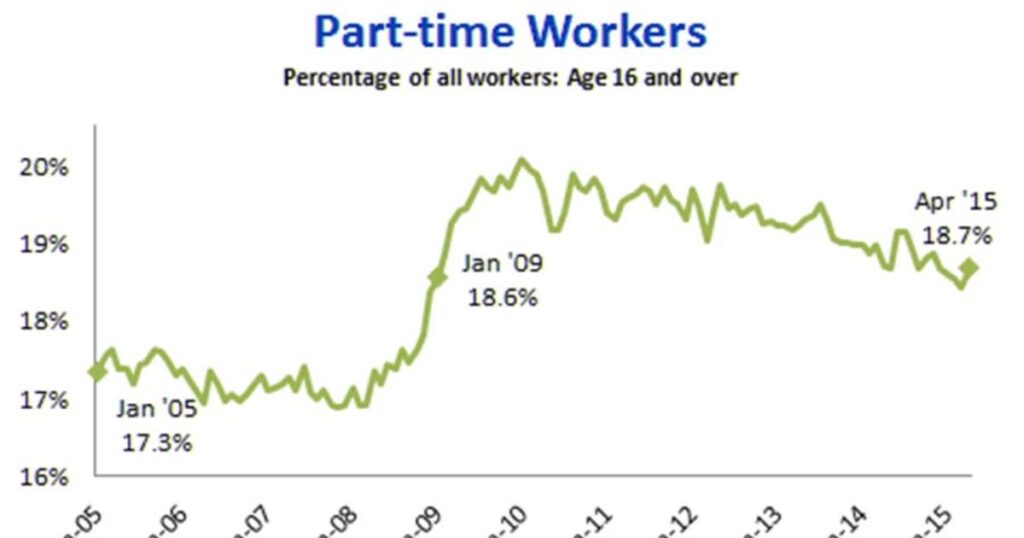Understanding Part-Time Work Hours in the United States
In today’s ever-evolving job market, flexibility has become a key factor for both employers and employees. Part-time work arrangements have gained significant popularity, allowing individuals to strike a balance between their professional and personal lives.
However, one common question that arises is, “How many hours is considered part-time work in the USA?” This comprehensive guide aims to provide clarity on this topic, exploring the nuances and variations that exist across different industries and states.
The concept of part-time work has become increasingly relevant in recent years, driven by changing societal norms, economic factors, and the rise of the gig economy.
As more individuals seek greater work-life balance or alternative income streams, part-time employment has emerged as a viable and attractive option.
However, navigating the intricacies of part-time work hours can be challenging, as definitions and regulations can vary significantly.
What is Part-Time Work?
Part-time work refers to employment that involves fewer hours than a typical full-time job. Unlike full-time employees who generally work 40 hours or more per week, part-time workers have a reduced work schedule.
It’s important to note that there is no universal definition of part-time work, as the specific number of hours can vary depending on the employer, industry, and state laws.
In essence, part-time work is characterized by a flexible arrangement that allows individuals to balance their work commitments with other aspects of their lives, such as family responsibilities, educational pursuits, or personal interests.
By working fewer hours, part-time employees often have the opportunity to allocate more time to non-work activities, leading to a better work-life balance.
How Many Hours Is Part-Time in the USA?

While there is no one-size-fits-all answer, generally, part-time work is considered to be any job that requires less than 30-35 hours per week.
However, the exact number can fluctuate based on various factors. Here are some common examples of part-time hour ranges:
- 20 hours per week
- 25 hours per week
- 30 hours per week
It’s crucial to understand that the specific definition of part-time work can vary significantly among employers and states.
Some companies may consider 32 hours per week as part-time, while others may set the threshold at 28 hours or even lower.
This variability highlights the importance of thoroughly understanding an employer’s policies and the relevant state laws when seeking or accepting a part-time position.
Factors Influencing Part-Time Work Hours
Several factors can influence the number of hours considered part-time work:
- Industry/Sector: Certain industries, such as retail, hospitality, and healthcare, tend to have a higher prevalence of part-time jobs. The specific number of hours may vary based on the industry’s needs and norms. For example, in the retail sector, where businesses often require extended operational hours, part-time work may be defined as fewer than 30 hours per week to accommodate shift schedules and staffing requirements.
- Company Policies: Employers have the flexibility to define their own policies regarding part-time work hours. These policies are often outlined in the employee handbook or employment contracts. Some companies may choose to offer a range of part-time options, such as 20-hour or 30-hour workweeks, to cater to the diverse needs of their workforce.
- State Laws: Some states have specific laws or regulations that define the number of hours that constitute part-time work. For example, in California, part-time work is generally considered to be anything less than 30 hours per week, while in New York, the threshold is often set at 20 hours per week for certain industries. Employers operating in multiple states must ensure compliance with the respective state laws governing part-time work hours.
It’s important to note that these definitions and thresholds can also vary based on the type of employment, such as exempt (salaried) or non-exempt (hourly) positions. Employers may have different criteria for determining part-time status for these two categories of workers.
Read this Post: HOME WARRANTY GEORGE FOREMAN
Benefits of Working Part-Time in the USA
Part-time work offers numerous advantages for individuals seeking a better work-life balance or those with specific personal or professional needs. Here are some key benefits of working part-time in the USA:
- Improved Work-Life Balance: With fewer hours spent at work, part-time employees can dedicate more time to personal pursuits, family responsibilities, or leisure activities.
This flexibility can be particularly valuable for individuals with caregiving duties, such as parents or those caring for elderly relatives.
“Working part-time has allowed me to be more present for my family while still maintaining a career path. It’s the perfect balance for me at this stage of life.” – Sarah, a part-time marketing professional. - Flexible Schedules: Many part-time jobs offer flexible scheduling options, allowing workers to accommodate other commitments or preferences.
This can include opportunities for remote work, condensed workweeks, or schedules that align with personal obligations like childcare or medical appointments. - Supplemental Income: Part-time work can provide an additional stream of income to supplement other sources or support specific financial goals.
For example, individuals may take on part-time roles to pay off student loans, save for a down payment on a home, or fund hobbies or personal projects. - Transition Opportunities: Part-time roles can be ideal for individuals transitioning back into the workforce after a break or for those preparing for semi-retirement.
These positions allow for a gradual re-entry or a smoother transition into retirement, providing a sense of continuity and purpose. - Potential Health Benefits: Some part-time positions may offer access to health insurance or other benefits, although the eligibility requirements can vary by employer and the number of hours worked.
While full-time employees typically have more comprehensive benefit packages, some part-time workers may still be able to access valuable healthcare coverage or retirement savings plans.
Common Part-Time Work Arrangements
Part-time work can take various forms, depending on the employer’s needs and the employee’s preferences. Here are some common part-time work arrangements:
- Job Sharing: In this arrangement, two part-time employees share the responsibilities of a single full-time position, dividing the workload and schedule between them.
This can be an attractive option for individuals seeking a reduced workload while maintaining continuity and collaboration with a colleague. - Term-Time Working: This option allows employees, typically those with children, to reduce their hours or take time off during school holidays, providing a structured approach to managing childcare responsibilities.
It enables parents to balance their work commitments with their family obligations throughout the academic year. - Freelance/Gig Work: Many individuals choose to work as freelancers or take on gig-based jobs, which offer flexibility in terms of hours and project selection.
This arrangement allows for a high degree of control over work schedules and the ability to take on multiple clients or projects simultaneously. - Seasonal Work: Certain industries, such as retail, hospitality, or tourism, may offer part-time opportunities on a seasonal basis to accommodate fluctuations in demand.
These positions can provide temporary employment during peak periods, allowing individuals to supplement their income or gain valuable work experience.
Rights and Protections for Part-Time Workers in the USA
While part-time workers may have fewer hours, they are entitled to certain rights and protections under federal and state laws. Here are some key considerations:
- Fair Labor Standards Act (FLSA) and Minimum Wage: Part-time workers are covered by the FLSA, which sets the federal minimum wage and overtime pay requirements.
Employers must comply with the FLSA’s provisions, ensuring that part-time employees are compensated fairly for their work hours, including overtime pay if applicable.
However, some states have their own minimum wage laws that may be higher than the federal level, and employers must adhere to the higher standard. - Anti-Discrimination Laws: Part-time workers are protected from discrimination based on factors such as race, color, religion, sex, national origin, age, disability, or genetic information.
Employers are prohibited from making hiring, promotion, or termination decisions based on these protected characteristics, regardless of an employee’s full-time or part-time status. - Access to Benefits: Depending on the employer’s policies and the number of hours worked, part-time employees may be eligible for certain benefits, such as health insurance, retirement plans, or paid time off. However, it’s common for employers to have different eligibility criteria or pro-rated benefits for part-time workers compared to full-time employees.
- Workplace Safety Standards: Part-time workers are entitled to a safe and healthy work environment, as mandated by the Occupational Safety and Health Administration (OSHA) and state-specific safety regulations.
Employers must provide appropriate training, personal protective equipment, and follow safety protocols for all employees, regardless of their work hours.
It’s important to note that while federal laws provide a baseline for worker protections, some states may have additional laws or regulations that offer enhanced rights and protections for part-time employees. Employers operating in multiple states should stay informed about the specific
Rights and Protections for Part-Time Workers in the USA (Continued)
It’s important to note that while federal laws provide a baseline for worker protections, some states may have additional laws or regulations that offer enhanced rights and protections for part-time employees.
Employers operating in multiple states should stay informed about the specific requirements in each jurisdiction to ensure compliance.
Furthermore, part-time workers may also be covered by collective bargaining agreements or union contracts, which can provide additional benefits, protections, and guidelines specific to their industry or workplace.
Advocacy and Resources for Part-Time Workers
While the laws and regulations surrounding part-time work aim to protect employees, navigating the complexities of part-time employment can still be challenging.
Fortunately, there are various organizations and resources dedicated to advocating for and supporting part-time workers in the USA:
- Labor Unions: Many labor unions, such as the Service Employees International Union (SEIU) and the American Federation of Labor and Congress of Industrial Organizations (AFL-CIO), have divisions or programs focused on part-time worker rights and advocacy.
- Workers’ Rights Organizations: Non-profit organizations like the National Employment Law Project (NELP) and the National Partnership for Women & Families work to promote fair labor practices, including advocating for part-time worker protections and benefits.
- Government Agencies: The U.S. Department of Labor and state labor departments provide information, resources, and complaint processes for workers, including part-time employees, to ensure their rights are upheld.
- Online Resources: Websites like PartTimeJobs.com, FlexJobs, and PartTimePros offer job listings, career advice, and community forums specifically tailored to part-time workers.
By leveraging these resources, part-time workers can stay informed about their rights, find support in addressing workplace issues, and explore opportunities that align with their needs and preferences.
Case Study: Part-Time Work in the Healthcare Industry
The healthcare industry is one sector that has seen a significant rise in part-time employment opportunities. Many healthcare facilities, such as hospitals, clinics, and nursing homes, require round-the-clock staffing, making part-time roles an attractive option for both employers and employees.
For example, consider the case of a registered nurse, Emily, who transitioned to part-time work after having her first child.
Emily’s employer, a local hospital, offered her the option to work 24 hours per week, split into three 8-hour shifts.
This arrangement allowed Emily to maintain her nursing career while also dedicating time to her family responsibilities.
From the employer’s perspective, offering part-time positions can be beneficial in attracting and retaining skilled healthcare professionals who may not be able to commit to full-time hours. It also provides scheduling flexibility to ensure adequate staffing coverage during various shifts and periods of high demand.
Additionally, part-time work in the healthcare industry can be an attractive option for semi-retired professionals or those seeking supplemental income.
By leveraging their expertise and experience, these individuals can contribute to the healthcare workforce while maintaining a desired work-life balance.
Comparing Part-Time and Full-Time Work

While part-time and full-time work share some similarities, there are key differences to consider:
| Aspect | Part-Time Work | Full-Time Work |
| Hours | Typically less than 30-35 hours per week | Typically 40 hours or more per week |
| Pay | Generally lower pay due to fewer hours worked | Higher pay due to more hours worked |
| Benefits | Eligibility for benefits may be limited or require a minimum number of hours worked | More comprehensive benefits often available |
| Job Security | Positions may be more temporary or subject to fluctuations in demand | Generally more stable and long-term |
| Career Advancement | Opportunities for promotion or career growth may be limited in some cases | More potential for career advancement and leadership roles |
| Work-Life Balance | Greater flexibility to balance work and personal commitments | Often less flexibility due to longer hours |
It’s important to note that these comparisons are generalizations, and the specific details may vary based on the employer, industry, and location.
Additionally, some employers may offer part-time employees opportunities for advancement or access to benefits on a pro-rated basis, depending on their policies.
“While full-time work was my initial goal, I’ve found that part-time employment provides me with the perfect balance of professional fulfillment and personal freedom.” – Jessica, a part-time graphic designer.
The Future of Part-Time Work
The landscape of part-time work is continuously evolving, driven by changing societal norms, technological advancements, and shifting workforce dynamics. Here are some potential trends and considerations for the future of part-time work:
- The Gig Economy:
The rise of the gig economy, facilitated by digital platforms and remote work opportunities, has opened up new avenues for part-time and flexible employment.
As more individuals embrace the freedom and autonomy of freelance or contract work, part-time arrangements may become increasingly prevalent across various industries. - Remote and Hybrid Work Models:
The COVID-19 pandemic has accelerated the adoption of remote work practices, blurring the lines between traditional full-time and part-time roles.
Employers may continue to offer hybrid or fully remote part-time opportunities, expanding the pool of potential candidates and allowing for greater flexibility. - Emphasis on Work-Life Balance:
As societal values shift towards prioritizing work-life balance and personal well-being, there may be an increased demand for part-time work options.
Employers may recognize the benefits of offering part-time arrangements as a means to attract and retain top talent while promoting employee satisfaction and productivity. - Changing Workforce Demographics:
With an aging population and the potential for extended working lives, part-time roles may become more attractive for semi-retired individuals or those seeking a gradual transition into retirement.
Additionally, the evolving needs of working parents and caregivers may drive the demand for flexible part-time opportunities. - Technological Advancements:
Advancements in automation, artificial intelligence, and other technologies may reshape the nature of work and the distribution of part-time and full-time roles across various industries.
Employers may leverage these technologies to create new part-time opportunities or redistribute workloads to accommodate part-time arrangements.
As the workforce continues to evolve, it is essential for employers, policymakers, and workers to adapt and embrace the changing landscape of part-time work, fostering a more inclusive and flexible labor market that meets the diverse needs of individuals and businesses alike.
Conclusion
Understanding the nuances of part-time work hours in the USA is crucial for both employers and employees. While there is no universal definition, part-time work is generally considered to be any job that requires less than 30-35 hours per week.
However, the specific number of hours can vary depending on factors such as industry, company policies, and state laws.
Part-time work offers numerous benefits, including improved work-life balance, flexible schedules, and supplemental income.
It also provides transition opportunities for individuals returning to the workforce or preparing for semi-retirement.
Additionally, part-time workers in the USA are entitled to certain rights and protections under federal and state laws, such as minimum wage, anti-discrimination laws, and workplace safety standards.
As the workforce continues to evolve, the future of part-time work is likely to be shaped by factors such as the gig economy, remote and hybrid work models, changing workforce demographics, and technological advancements.
Employers and policymakers will need to adapt and embrace the changing landscape of part-time work to foster a more inclusive and flexible labor market.
Ultimately, the decision to pursue part-time work should be based on individual circumstances, preferences, and career goals.
By understanding the landscape of part-time work hours and arrangements, individuals can make informed choices that align with their personal and professional needs, while employers can leverage part-time opportunities to attract and retain a diverse and skilled workforce.

Ava, boasting five years in home blogging, shares expertise in domestic living. With a sharp eye and passion for details, she navigates home decor and lifestyle intricacies effortlessly.







